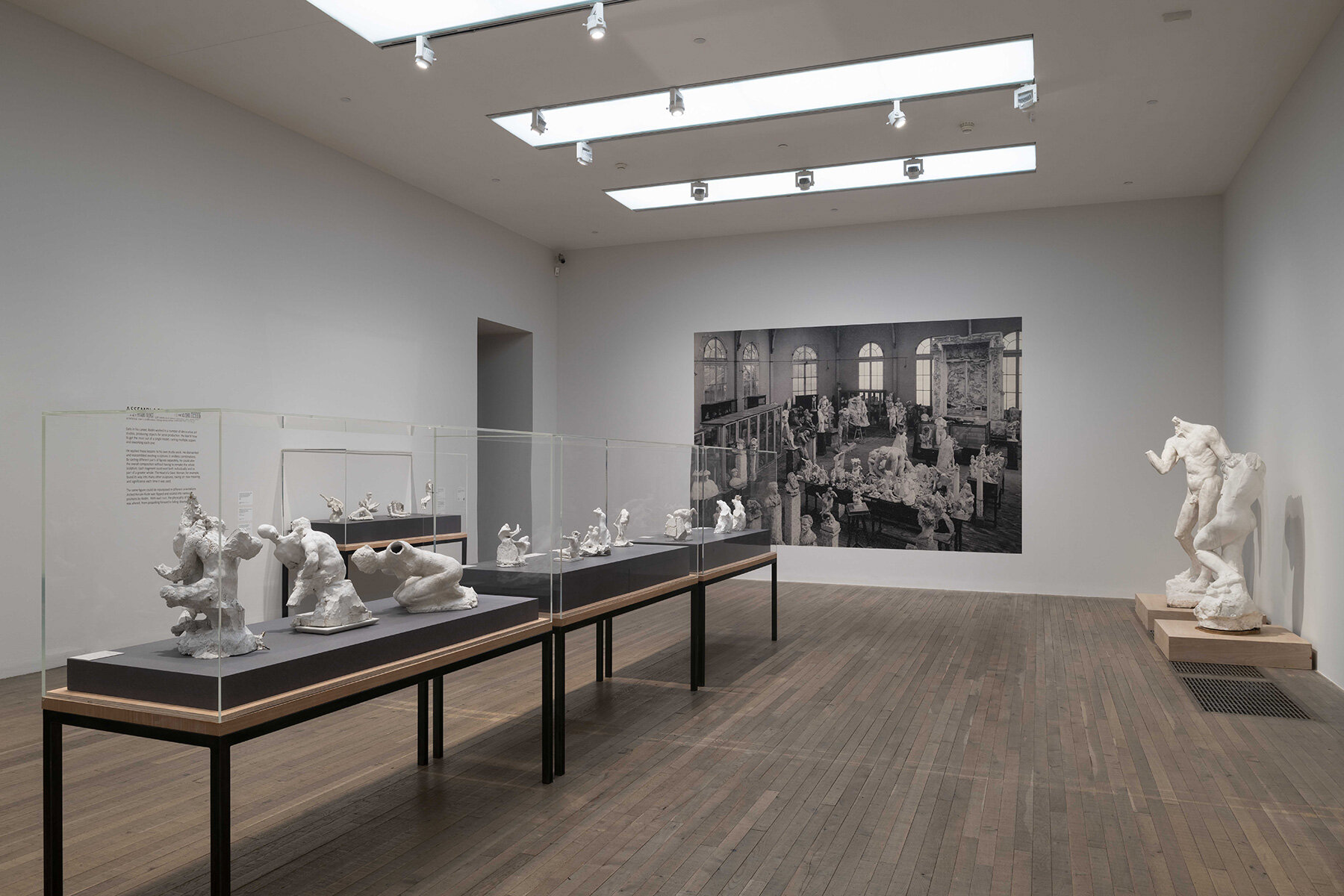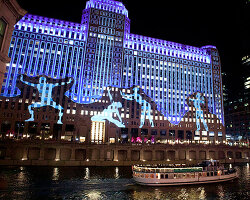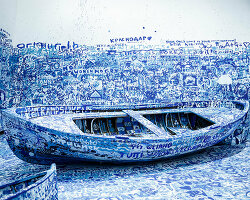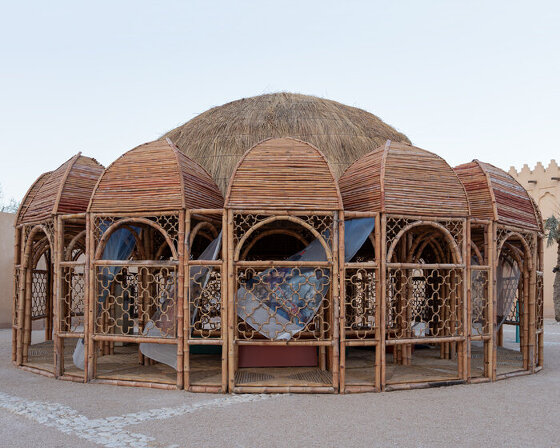from now through november 21, 2021, tate modern presents a major exhibition dedicated to auguste rodin, featuring more than 200 works, many of which have never been shown outside france. the EY exhibition: the making of rodin sheds rare insight into rodin’s thinking and making, demonstrating his rule-breaking approach to classical sculpture in an effort to echo the complexities of the modern age. although rodin is best known for his bronze and marble sculptures, he personally only worked as a modeller. he captured motion, emotion, light and volume in pliable materials such as clay, which were later cast in plaster.
the exhibition at tate modern is the first to focus in-depth on rodin’s use of plaster — a theme that draws from the self-organized retrospective he mounted at the pavillon de l’alma in paris in 1900. here, in a structure built specially for the occasion and staged as vision of the artist’s studio, rodin made the unconventional and daring decision to display his life’s work almost entirely in plaster. like the exhibition at pavillon de l’alma, the EY exhibition: the making of rodin underscores the crucial role plaster played in rodin’s oeuvre, demonstrating how his experiments with fragmentation, repetition and reassembly went on to influence some of his best-known sculptures.

jules richard rodin dans son atelier musée rodin, ph.02392 © musée rodin
visitors to the EY exhibition: the making of rodin at tate modern are invited to appreciate the originality of iconic works, as well as uncover new revelations about how the artist transformed modern sculpture — thanks to a collaboration with the musée rodin, who offered tate unprecedented access to their collection. within gallery spaces that evoke the atmosphere of the pavillon de l’alma, the complex dynamics of rodin’s work, specifically with different collaborators, are deeply considered. ‘the exhibition explores the studio as a constellation of models, assistants, carvers, casters, founders and photographers who collectively contributed to the production of rodin’s work’, helen o’malley, assistant curator at tate modern, tells designboom. ‘while the initial clay model and overall vision lay securely with rodin, he recognised the value and necessity of collaboration.’ meanwhile, archival images show how his use of photography allowed him to explore combinations of forms, and analyze his sculptures from multiple viewpoints.
to learn more about this exciting exhibition, designboom spoke with helen o’malley — assistant curator at tate modern — about the show’s highlights, its references to rodin’s retrospective at the pavillon de l’alma, and the new perspectives it uncovers about his practice.

the EY exhibition: the making of rodin installation view © tate photography (matt greenwood)
designboom (DB): how does the exhibition unfold across tate modern’s spaces, and what are some of the highlights visitors can look forward to?
helen o’malley (HO’M): rodin is best known for his sculptures in bronze and marble, however the EY exhibition: the making of rodin focuses specifically on rodin’s work in plaster. the exhibition takes inspiration from rodin’s landmark, self-curated retrospective at the pavillon de l’alma in 1900. he made the unconventional decision to display his life’s work almost entirely in plaster. he also decided to break with the typical exhibition layout of the time. rather than creating a linear display of the official salon system, he scattered his artworks through the pavilion, clustering them in unexpected and irregular groupings. this layout conjured up the atmosphere of an artist’s studio, suggesting to visitors that they were being given privileged access to his creative working process.

the EY exhibition: the making of rodin installation view © tate photography (matt greenwood)
HO’M (continued): rodin’s work in plaster allowed him to move away from traditional notions of beauty and the idealised body, focusing instead on the importance of process, materiality and creative accident. the exhibition offers visitors an insight into his radical working methods, including his experimental use of fragmentation, multiplication, repetition, assemblage and enlargement. while plaster was treated as a secondary or transitional medium by the majority of french sculptors at that time, rodin recognised its unique creative potential. through his use of plaster, rodin developed a new aesthetic which set him apart from his contemporaries.
the exhibition has been made possible thanks to an unprecedented collaboration with the musée rodin in paris. it will offer visitors an opportunity to explore unfamiliar facets of the artist’s most iconic works, such as the thinker and the burghers of calais. it will also present lesser known works such as the abattis and portraits of ohta hisa, also known as hanako. finally, it will reunite many of the star exhibits of the 1900 retrospective, such as the monumental cast of balzac and the inner voice.

the EY exhibition: the making of rodin installation view © tate photography (matt greenwood)
DB: what does the exhibition reveal about rodin’s studio, and specifically the dynamics between models and collaborators at the workshop?
HO’M: as much as the exhibition aims to celebrate rodin’s bold over-turning of conventions, it also hopes to deconstruct the myth of the ‘lone male genius’. rodin worked with a team of over 20 people. the exhibition explores the studio as a constellation of models, assistants, carvers, casters, founders and photographers who collectively contributed to the production of rodin’s work. while the initial clay model and overall vision lay securely with rodin, he recognised the value and necessity of collaboration. studio assistants, such as camille claudel, played an integral role in the development of his work. he also drew upon the expertise of specialist technicians including plaster caster, paul cruet; enlarger henri lebossé; founder, alexis rudier and photographer, eugène druet.
rodin’s models played a unique role in the realisation of his work. rather than instructing his sitters to strike fixed poses, he would ask them to move freely around the studio. when a gesture or movement caught his attention, he would record it quickly on paper. rodin strongly responded to the individual character and physicality of his models. this is especially evident in his numerous portraits of the japanese actress and dancer, ohta hisa and the german aristocrat helene von nostitz.

auguste rodin study for the thinker, 1881 musée rodin, s.01168
DB: in developing the exhibition, what did you learn about rodin’s making and creative process that you might not have previously known? did anything surprise you?
HO’M: at the beginning of his career, rodin worked in a number of decorative art studios. he learnt a range of industrial multiplication processes, which he later began to apply to his figurative work. in the three shades, a single male figure is repeated three times. the individual figures rotate around a central anchor point, each at a slightly different angle. rodin’s decision to present duplicates of a single form within the same group was a radical departure from the nineteenth-century emphasis on sculptures as unique object.
between 1880-1900, rodin built up a large collection of individually modelled hands, heads, arms and legs. he referred to these limbs as ‘abattis’. multiple copies of each limb were produced. the ‘abattis’ never belonged to just one figure, but represented a stockpile of parts to draw upon. rodin dismantled and reassembled these fragments in countless combinations, as seen in assemblage: the american athlete and the prayer, small model, without right leg with the head of woman with a bun. rodin’s re-built bodies challenged the idealised notion of beauty. it was no longer a matter of creating a good likeness of his model, or a complete figure, but of using his work to reconsider fundamental questions of representation and form.

auguste rodin head of the thinker against a panel, 1880, musée rodin, s.01916
HO’M (continued): rodin’s use of the camera was also extremely exciting. he was born in 1840, just two years after louis daguerre invented photography. although he never took a photograph himself, he worked in close collaboration with a number of photographers, including eugène druet, jacques-ernest bulloz and edward steichen. rodin was heavily involved in the composition of each image. he used the camera as an editing tool. the 2D images allowed him to disconnect from the physical work. previously this sense of detachment could only be achieved by setting the work aside for a week or more. photography became an increasingly indispensable part of rodin’s practice. he made the decision to feature photographs in his 1900 retrospective at the pavillon de l’alma.

the EY exhibition: the making of rodin installation view © tate photography (matt greenwood)
DB: what do you hope visitors take away from the show? what new perspectives can be uncovered about the importance of plaster in rodin’s work?
HO’M: the EY exhibition: the making of rodin is the first exhibition to focus on rodin’s use of plaster. it features over 200 works, a third of which have never been shown publicly until now. rodin challenged the conventions of classical sculpture. by breaching the prevailing codes of representation, he opened the way to a new modernity. I hope this exhibition will offer new insights into rodin’s practice, highlighting how his experimental use of materials and techniques lastingly expanded the field of sculpture.

auguste rodin, limbs, circa 1880–1917 | plaster and terracotta | musée rodin | photo © agence photographique du musee rodin – jerome manoukian

auguste rodin right hand of pierre and jacques de wissant, 1885–86 musée rodin, s.00332

the EY exhibition: the making of rodin installation view © tate photography (matt greenwood)

the EY exhibition: the making of rodin installation view © tate photography (matt greenwood)

the EY exhibition: the making of rodin installation view © tate photography (matt greenwood)

auguste rodin the three shadows, before 1886, musée rodin, s.03970

the EY exhibition: the making of rodin installation view © tate photography (matt greenwood)

auguste rodin the tragic muse, 1890 musée rodin, s.01992

auguste rodin hanako mask, type E, 1907-10, musée rodin; s.00194
exhibition information:
the EY exhibition: the making of rodin
location: tate modern
dates: may 17 – november 21, 2021
art interviews (162)
sculpture (403)
tate modern (29)
PRODUCT LIBRARY
a diverse digital database that acts as a valuable guide in gaining insight and information about a product directly from the manufacturer, and serves as a rich reference point in developing a project or scheme.



















